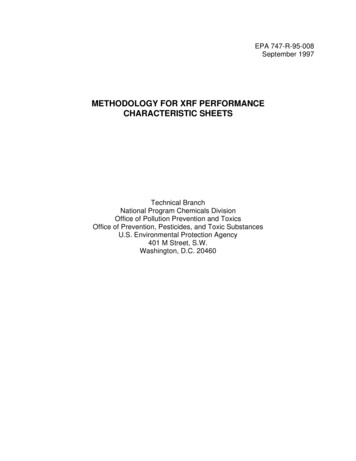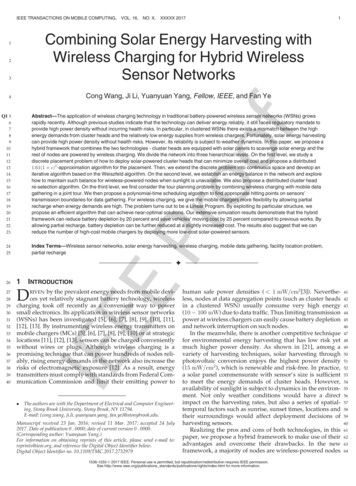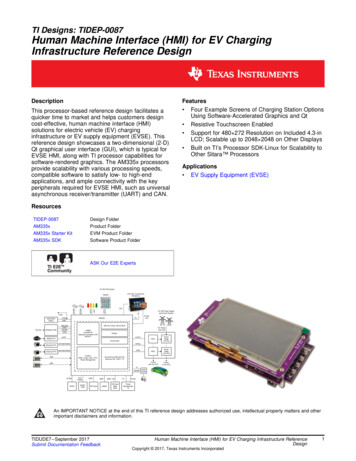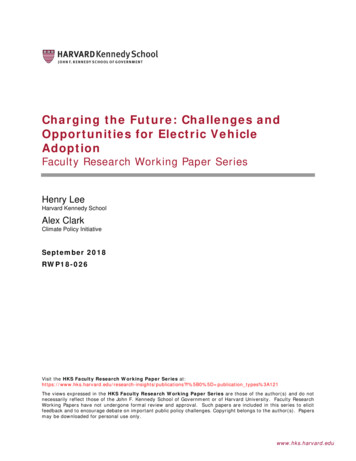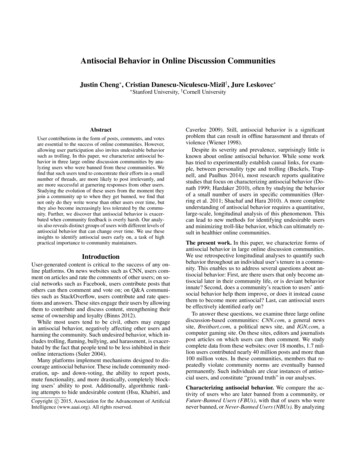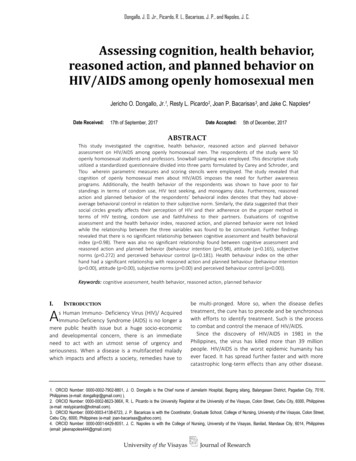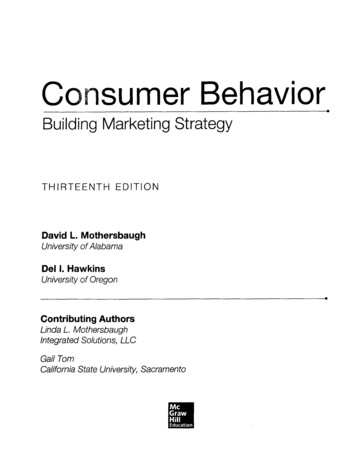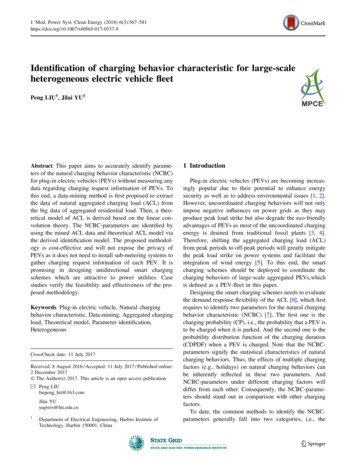
Transcription
J. Mod. Power Syst. Clean Energy (2018) 337-5Identification of charging behavior characteristic for large-scaleheterogeneous electric vehicle fleetPeng LIU1, Jilai YU1Abstract This paper aims to accurately identify parameters of the natural charging behavior characteristic (NCBC)for plug-in electric vehicles (PEVs) without measuring anydata regarding charging request information of PEVs. Tothis end, a data-mining method is first proposed to extractthe data of natural aggregated charging load (ACL) fromthe big data of aggregated residential load. Then, a theoretical model of ACL is derived based on the linear convolution theory. The NCBC-parameters are identified byusing the mined ACL data and theoretical ACL model viathe derived identification model. The proposed methodology is cost-effective and will not expose the privacy ofPEVs as it does not need to install sub-metering systems togather charging request information of each PEV. It ispromising in designing unidirectional smart chargingschemes which are attractive to power utilities. Casestudies verify the feasibility and effectiveness of the proposed methodology.Keywords Plug-in electric vehicle, Natural chargingbehavior characteristic, Data-mining, Aggregated chargingload, Theoretical model, Parameter identification,HeterogeneousCrossCheck date: 11 July 2017Received: 8 August 2016 / Accepted: 11 July 2017 / Published online:2 December 2017 The Author(s) 2017. This article is an open access publication& Peng LIUliupeng hit@163.comJilai YUyupwrs@hit.edu.cn1Department of Electrical Engineering, Harbin Institute ofTechnology, Harbin 150001, China1 IntroductionPlug-in electric vehicles (PEVs) are becoming increasingly popular due to their potential to enhance energysecurity as well as to address environmental issues [1, 2].However, uncoordinated charging behaviors will not onlyimpose negative influences on power grids as they mayproduce peak load strike but also degrade the eco-friendlyadvantages of PEVs as most of the uncoordinated chargingenergy is drained from traditional fossil plants [3, 4].Therefore, shifting the aggregated charging load (ACL)from peak periods to off-peak periods will greatly mitigatethe peak load strike on power systems and facilitate theintegration of wind energy [5]. To this end, the smartcharging schemes should be deployed to coordinate thecharging behaviors of large-scale aggregated PEVs,whichis defined as a PEV-fleet in this paper.Designing the smart charging schemes needs to evaluatethe demand response flexibility of the ACL [6], which firstrequires to identify two parameters for the natural chargingbehavior characteristic (NCBC) [7]. The first one is thecharging probability (CP), i.e., the probability that a PEV isto be charged when it is parked. And the second one is theprobability distribution function of the charging duration(CDPDF) when a PEV is charged. Note that the NCBCparameters signify the statistical characteristics of naturalcharging behaviors. Thus, the effects of multiple chargingfactors (e.g., holidays) on natural charging behaviors canbe inherently reflected in these two parameters. AndNCBC-parameters under different charging factors willdiffer from each other. Consequently, the NCBC-parameters should stand out in comparison with other chargingfactors.To date, the common methods to identify the NCBCparameters generally fall into two categories, i.e., the123
568stochastic simulating methods [8–13] and the sub-meteringmethods [14–17]. For the stochastic simulating methods,travel patterns of internal combustion engine vehicles areused to simulate PEV charging behaviors and then to calculate NCBC-parameters [13]. For the sub-meteringmethods, a central authority or coordinator is required togather and process the data regarding the charge requestinformation of each PEV, such as the time when the PEV isplugged in, the duration of charging and the charging rate,etc. [14].Most of the existing stochastic simulating methods, byand large, suffer from lack of accuracy. In practice, a PEVfleet consists of heterogeneous vehicles and the chargingparameters of them such as battery capacities, chargingrates and the amounts of energy consumed per mile, etc.differ significantly [18]. Besides, the charging habits andusages (commuting or non-commuting) are also differentamong PEVs [4, 18]. Thus, the charging behaviours varysignificantly among the vehicles in a PEV-fleet [18]. Mostof the existing simulation methods may not accuratelysimulate charging behaviours of the PEV-fleet.The sub-metering methods need to build expensive submetering systems to gather the data with regard to thecharging request information of PEVs [6, 14]. Thesemethods usually aim at designing demand managementparadigms that are based on the real time pricing mechanisms. For many power utilities, the main impediment forsuch paradigms is that their residential customers may notbe receptive to the true dynamic pricing schemes [3, 19].For the power utilities whose residential customers prefertime-of-use price schemes, sub-metering systems are notnecessities for the customers and the utilities are alsounwilling to improve their measurement systems due to thehigh cost of investment, operation as well as maintenance[20]. Thus, the sub-metering methods are not suitable forthese kinds of power utilities since the charging requestinformation of PEVs are not available.This paper aims to accurately identify the NCBC-parameters without measuring data regarding the chargingrequest information of PEVs. If PEVs are popularized, theaggregated residential load will consist of three components, i.e., climate-sensitive load (CSL) [21], base load andACL. The CSL is due to the utilization of air-conditionersand electric heaters during summer and winter, and thebase load is owing to the daily usage of basic householdappliances such as TVs, computers, water heaters, lightinglamps, washing machines, etc. For a large-scale PEV-fleet,the charging patterns of PEVs tend to be statistically steadyand therefore, the ACLs during a specific time window willfall into a narrow band. The statistically steady chargingpatterns imply the predictability of NCBC-parameterswhich can be used to calculate ACL, leading to aremarkable regularity and predictability of time-varying123Peng LIU, Jilai YUACL. Our study is originally motivated by two basic ideas: The data of natural ACL can be mined from the big dataof aggregated residential load of large-scale households. NCBC-parameters can be identified via the mined ACLdata based on theories of linear convolution and parameteridentification.This paper proposes a novel methodology to identify theNCBC-parameters of the large-scale heterogeneous PEVfleet. The contributions of this paper are summarized asfollows:1)2)3)A data mining method is originally proposed. By usingthe proposed method, the natural ACL data can be minedout from the available big data of the aggregatedresidential load. The mined ACL data includes theintegrated charging characteristic information of a largescale heterogeneous PEV-fleet. Thus, the proposed datamining method will help understand the integratedfeatures of ACL from the system level’s perspective.A theoretical ACL model for the large-scale heterogeneous PEV-fleet is originally derived. Compared toexisting models [22–25], the derived ACL model isable to calculate the actual ACL in an integrated wayby using the actual NCBC-parameters. Thus, it doesnot need to divide the heterogeneous PEV-fleet intoseveral homogenous sub-PEV-fleet and calculate theACL for each homogeneous sub-PEV-clusterseparately.A mathematic model is originally build to identify theNCBC-parameters via the mined ACL data and thederived theoretical model. The identification model isformulated as a non-linear programming model thatcan be solved by the commonly applied interior pointalgorithm. The identified NCBC-parameters will helpevaluate the demand response flexibility of naturalACL. Thus, the identification model is promising indesigning unidirectional smart charging programs thatrely heavily on the integrated information of ACL butslightly on individual information of each PEV, suchas wind-to-vehicle pricing programs, etc.The proposed methodology will acquire comparableresults with the sub-metering methods, yet does not need toobserve the individual information of each PEV. As aresult, it does not need to build expensive sub-meteringsystems and will not expose the privacy of PEVs.The rest of this paper is organized as follows. In Sect. 2,an overview of the proposed methodology is provided. InSect. 3, a method of mining the natural ACL data is proposed. Section 4 derives a theoretical model for ACLcalculation. Section 5 introduces the identification ofNCBC-parameters based on the mined ACL data and thederived ACL model. Section 6 presents the case studiesand Sect. 7 concludes this paper.
Identification of charging behavior characteristic for large-scale heterogeneous electric 5692 Overview of proposed methodology3 Data-mining methodThe block diagram of the proposed methodology isshown in Fig. 1. The identification of NCBC-parametersconsist of two modules. The first one is responsible formining the big data of aggregated residential load to obtainthe natural ACL data, and the second one is responsible foridentifying the NCBC-parameters via the mined ACL databased on the derived ACL model. The procedures toidentify the NCBC-parameters are summarized as follows:Travel patterns of a PEV during weeks seldom repeat,yet the integrated trip behaviors of large-scale PEVs tend tofollow a repeatable pattern during weeks. Statistical distributions of variables used to describe the trip behaviorssuch as the time when a PEV arrives home, the daily tripdistance, etc., repeat in different weeks [26]. Thus, theACL and NCBC-parameters of a large-scale PEV-fleetwill, by and large, recur in different weeks. Hence, a timewindow of 168 h (i.e., a week) will include all possiblecharging behaviors of PEVs’ owners [27]. Hence, the dataof weekly ACLs should be used to identify the NCBCparameters.To demonstrate the proposed ACL data-mining method,the data of actual aggregated residential load of 6 9 105households in a city of north China during the recent8 years (2008–2015) are selected to form the originaldatasets. And the actual residential load data in 2008–2014are gathered to form a dataset that is denoted as NRL. It isassumed that the load in NRL do not include ACL since thecharging load of PEVs during these years can be neglected.As PEVs are not popularized to date, the data of weeklyACLs are generated by using the actual distributions of tripdata via stochastically simulating the natural chargingbehaviors of 1 9 105 heterogeneous PEVs.The distributions of trip data are obtained from theBeijing Transportation Research Centre [28]. The PEVs inthe simulation include PHEVs, Mini EVs, Compact EVsand Medium EVs. PEVs of each type contain both commuting vehicles and non-commuting vehicles dependingon their usages. A PEV-owner’s charging habit is quantified by his/her psychological buffer of the battery which isdefined as a specific amount of battery energy [4], belowwhich he/she will suffer the range anxiety. A parked PEVwill be charged if the remaining battery energy is less thanthe sum of its owner’s psychological buffer and the batteryenergy to cover the next trip [4].The required trip data and charging parameters aresummarized in [18]. Noted that the trip data reflect theactual trip behaviors of the private cars in Beijing. Thecharging parameters are obtained by survey on the internetand thereby they are relatively accurate. Therefore, thegenerated ACL is reasonable. These ACL data are thenadded to the residential load data of 2015 to form anotherresidential load dataset from which the ACL data should bemined out. This dataset is denoted as RL. The constructeddataset RL can be treated as a reasonable dataset thatincludes ACL. An overview of the stochastic simulationcan be found in the Sect. 6. The details of the simulationmethod can be found in [18].1)2)3)Mine the big data of the aggregated residential load toobtain the data of the natural ACL. In this step, thenatural ACL data are mined out from the aggregatedresidential load by using the proposed data-miningmethod.Derive a theoretical ACL model for the large-scaleheterogeneous PEV-fleet. In this step, a theoreticalACL model for the PEV-cluster with homogenouscharging rate is first derived based on the linearconvolution theory. Then, an improved model isproposed to calculate the ACL of the realistic(heterogeneous) PEV-fleet.Estimate NCBC-parameters based on the mined ACLdata and derived theoretical ACL model. In this step,the NCBC-parameters are identified by using thederived identification model.These steps will be discussed sequentially. Since mostPEV owners prefer to charge their vehicles at home [4],only the charging behaviors occurring at home are studiedin this paper. Moreover, each day is divided into 48 timeperiods with each time-period lasting 0.5 h. The 48 timeperiods are numbered from 1 to 48 with the index of0:00–0:30 being 1 and 23:30–24:00 being 48.Note that both the ACL and the NCBC-parameters arecontinuous variables that vary with time. To reduce theorder of identification, we discretize these variables witheach time-period (0.5 h). That is to say, the value of ACLin a time-period is actually the average value during thattime-period. And the NCBC-parameters in a time-periodare counted by using all of the PEVs that are plugged intothe grid during that time-period. According to the law oflarge number, the ACL and NCBC-parameters of largescale PEV-fleet during a time-period tend to be statisticallysteady.InputsResidentialloadsACL profileACLdata-miningModule 1OutputsConvolution ACL modelParameter identificationNCBCparametersModule 2Fig. 1 Procedures for the identification of NCBC-parameter123
570Peng LIU, Jilai YUIt should be noted that, the generated load data in RL arenot the actual load data and they are only used for thedemonstration of the data-mining method in this Section.After the PEVs are popularized, one can just use the loaddata of a year to form this dataset. In this section, wedemonstrate that the ACL component of the residentialload in RL can be obtained by using the residential load inNRL.The weekly ACL curve can be easily obtained bysequentially connecting the daily ACL curves according totheir days in the week. As a result, the core of the datamining method is to extract all the daily ACLs from theresidential loads in RL. The residential loads in RL on aregular day are shown in Fig. 2a. The green and red areasdenote the base load component and CSL componentrespectively. And the blue area denotes the ACL component. Noted that, each load component shown in Fig. 2a isa time-sequence that consists of 48 load values in all timeperiods of the day. For the residential loads on any givenregular day in RL (see Fig. 2a), the procedures to mine theACL component are shown in Fig. 3. They are summarizedas 4 steps.1)2)3)4)Generate two template pools for the per-unit base loadprofile and the per-unit CSL profile via the datasetNRL.Identify per-unit load profiles for the components ofbase load (green area in Fig. 2a) and CSL (red area inFig. 2a) by using the two template pools.Identify actual load values in a specific time-period forthe components of base load and CSL.Calculate the base load and CSL components by usingthe identified per-unit load profiles and the actual loadvalues in a specific time-period, and then subtractthese two components from the daily residential loadsto obtain the ACL component (blue area in Fig. 2a).These 4 steps will be discussed in detail from Sects. 3.1 to3.4.StartDataset NRLStep 1Step 2DetailsGeneratetemplate pools1Dataset notincluding CSL2Datasetincluding CSLIdentify per-unitload profileStep 3Identify an actualload in a periodStep 4Calculate ACLcomponentCSL acquisitionCSL componentsin NRLLoad data normalizationPer-unit baseload poolEndPer-unit CSLpoolFig. 3 Work flow of data mining method3.1 Template pool generationThe generation of template pools for the per-unit baseload profile and the per-unit CSL profile requires largeamounts of base loads and CSL loads. The CSL heavilyrelies upon the temperature factors [29–33]. By using thedataset NRL, the linear correlation coefficients between thedaily residential peak loads and the temperature factors arecalculated. The results are shown in Table 1. In this table,Tmax is the daily maximum temperature; Tmin is the dailyminimum temperature; T2 , T8 , T14 and T20 are temperaturesat 2:00, 8:00, 14:00 and 20:00.Table 1 shows that, there is no strong correlationbetween the temperature factors and the daily residentialpeak load on days in spring and autumn. As a result, residential loads during spring and autumn can usually betreated as base loads which are rarely influenced by temperature factors [29–32]. Table 1 also shows that, the residential peak loads are most correlated with the dailymaximum temperature on days in summer and winter. Thisindicates that the daily maximum temperature has theheaviest influence on the CSL among the temperatureTable 1 Linear correlation coefficients between daily peak load andtemperature factorsTemperatureFig. 2 Residential load curves on two regular days123Linear correlation 9-0.59
Identification of charging behavior characteristic for large-scale heterogeneous electric factors shown in Table 1. Therefore, the daily maximumtemperature is more suitable than the other temperaturefactors to signify whether there is CSL or not on days insummer and winter [29–33].For further demonstration, the temperature sensitivity ofthe daily residential peak load is analyzed by using thedataset NRL. Figure 4 shows the analyzing results. Foreasy understanding, the daily peak load in a year is normalized to the average peak load at 20 C within the sameyear. Due to the operation of air conditioners and electricheaters, the daily peak load starts to increase once themaximum temperature is above 27 C or below 14 C.Figure 4 indicates that air-conditioners and electric heatersbarely work on days with the maximum temperaturebetween 14 C and 27 C. Thus, residential loads in thedataset NRL (for the case in the paper) can be treated asbase loads on days with maximum temperatures between14 C and 27 C. And most of the CSLs exist on days withthe maximum temperature being above 27 C or below14 C.For the used dataset NRL in this paper, we only selectthe residential loads on days with the maximum temperature being in [14, 27 C] as the actual base loads. This willexclude the effects of CSLs and obtain the relativelyaccurate base loads. It is worthy to point out that the rangeof temperature ([14, 27 C] for the case in the paper) variesamong cities [33]. Even though, similar results are alsoobtained in the studies [29–31]. Once the dataset NRL of acity is obtained, one can easily identify this temperaturerange.The template pools can be generated via the datasetNRL. The generation procedures can be found Fig. 3. Thedataset NRL is first divided into 2 sub-datasets. The residential load data on days with the maximum temperaturebeing in [14, 27 C] are gathered to form the 1st sub-datasetand the other load data in NRL are collected to form the 2ndsub-dataset. As indicated in Fig. 4, the load in the 1st subdataset can be treated as the base load. And the load in the2nd sub-dataset is the summation of base load and CSL.Then, the 48 load values of each day in the 1st sub-datasetare normalized to their maximum load value to obtain thecorresponding per-unit base load profile. Per-unit loadFig. 4 Influence of maximum temperature of the day on daily
mining the big data of aggregated residential load to obtain the natural ACL data, and the second one is responsible for identifying the NCBC-parameters via the mined ACL data based on the derived ACL model. The procedures to identify the NCBC-parameters are summarized as follows: 1) Mine the big data of the aggregated residential load toCited by: 5Publish Year: 2018Au
